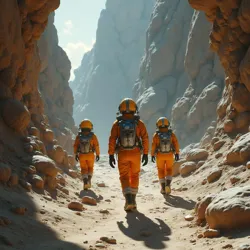On the Rocks: The Humorous Chronicles of Asteroidal Habitation

Life in the Asteroid Belt depicted with humor and resilience despite the challenges of space
Belter culture humor
Asteroid Belt
Rockhoppers
challenges of space homesteading
vacuum leaks, meteoroid showers, logistical absurdities
Void Shanties, stand-up comedy
coping mechanism, social cohesion
Asteroid Belt Comedy Festival
The settling of the Asteroid Belt by humanity, often depicted in dramatic or perilous terms, has in actuality given rise to a uniquely wry and often absurd culture amongst its inhabitants. Far from the desolate and lonely existence frequently imagined, life amongst the Ceres System|Ceresian Rings and beyond is characterized by a resilient, resourceful, and remarkably light-hearted approach to the myriad challenges of extra-terrestrial homesteading. The so-called "Belt-Dwellers," or more colloquially, "Rockhoppers," have forged a civilization not in spite of, but rather because of, the inherent difficulties of their environment, finding humor in the face of vacuum leaks, meteoroid showers, and the ever-present logistical absurdities of a life lived in the cold expanse between worlds.
The Girdle of Gravel and Grit: An Unlikely Locale for Levity
The Asteroid Belt itself, sometimes referred to as the "Main Asteroid Belt" to distinguish it from other celestial debris fields, is a toroidal region of space located roughly between the orbits of Mars and Jupiter. Contrary to popular depictions of a densely packed field of tumbling rocks, the Belt is, in fact, largely empty space. The average distance between asteroids is estimated to be in the millions of kilometers, meaning that interstellar navigation within the Belt is less akin to navigating a dense minefield and more like sailing across a vast ocean dotted with occasional, albeit substantial, islands. These "islands" are the asteroids themselves, ranging in size from mere pebbles to dwarf planets like Ceres (dwarf planet)|Ceres, the largest object in the Belt and a significant hub of human activity.
 The Asteroid Belt depicted as a vast empty space with scattered asteroids between Mars and Jupiter contrary to popular dense portrayals
The Asteroid Belt depicted as a vast empty space with scattered asteroids between Mars and Jupiter contrary to popular dense portrayalsThe environment of the Belt presents a constant, if often understated, set of comedic possibilities. The near-vacuum conditions, while essential for certain industrial processes, also mean that even minor malfunctions in habitat seals can lead to rapid decompression events, often described in Belter Folklore with a gallows humor that outsiders find unsettling. Similarly, the constant threat of micrometeoroid impacts, while statistically low for larger, well-shielded habitats, is a perpetual background anxiety that is frequently defused with sardonic jokes about "space dandruff" and the cosmic lottery of being struck by a rogue pebble.
Temperature extremes are another source of daily amusement and frustration. Asteroids lack atmospheres to regulate temperature, resulting in drastic swings between sunlit and shadowed sides. Habitats must be meticulously engineered to manage these thermal fluctuations, and power failures can lead to rapid shifts from sweltering heat to bone-chilling cold, often within the same workday. This environmental volatility has fostered a Belter sense of adaptability and a penchant for dark humor, as encapsulated in the common saying, "If you don't laugh, you'll freeze solid… or boil like a lobster, depending on which way the rock turns."
Gravity's Gentle Nudge: The Low-G Lifestyle
Perhaps the most pervasive and consistently comedic aspect of Belter life is the variable and often minimal gravitational pull experienced on most asteroids. While larger bodies like Ceres and some of the major asteroids possess enough gravity to allow for relatively normal terrestrial movement, many smaller settlements are situated on asteroids with negligible gravitational fields. This necessitates the use of magnetic boots, handholds, and carefully planned movement routines to avoid unintended floating and collisions.
The low-gravity environment has given rise to a unique Belter physicality, often characterized by elongated limbs and a certain looseness of gait when under artificial gravity conditions. Visitors from planets with standard gravity often remark on the "Belter Bounce," a slightly exaggerated spring in the step that becomes ingrained after years of navigating low-G environments. This physical adaptation, while practical in the Belt, can be a source of considerable amusement when Belters visit higher gravity worlds, leading to clumsy stumbles and comical misjudgments of momentum.
Furthermore, everyday activities take on a different, often humorous, dimension in low gravity. Eating, drinking, and even personal hygiene become exercises in controlled motion and containment. Spilled liquids become floating globules, food must be carefully managed to avoid becoming airborne, and even simple tasks like brushing teeth require a degree of spatial awareness and dexterity that would be unnecessary on a planetary surface. Belter Humor is replete with anecdotes of food fights turning into zero-gravity ballets of flying comestibles, or of attempts at romantic gestures being comically undermined by unexpected drifts and tumbles.
The Echoes of Earth, Amplified and Distorted
Despite the starkly different environment, Belter culture retains a clear lineage to Earth, albeit one that has been filtered through the lens of space and hardship, often resulting in humorous distortions and reinterpretations of terrestrial customs. For instance, holidays celebrated on Earth have been adapted and re-contextualized within the Belter setting. Christmas might be observed with the exchange of vacuum-sealed gifts and carols sung in pressurized habitats, while Thanksgiving might be celebrated with synth-grown turkey substitutes and toasts to the life support systems that keep them alive.
Language in the Belt has also evolved, incorporating elements from various Earth languages and developing its own unique slang and idioms. "Belter Creole," a pidgin language drawing heavily from English, Spanish, Mandarin, and Russian, is widely spoken throughout the Belt, facilitating communication between the diverse communities scattered across the asteroids. This linguistic melting pot is a fertile ground for humor, with puns and wordplay that often rely on the misinterpretations and juxtapositions of different linguistic traditions. For example, a common Belter joke involves mistranslating Earth idioms into Belter Creole, highlighting the absurdity of applying terrestrial concepts to the spacefaring context.
The Rockhopper Ethos: Finding the Funny Side of Hardship
The humor of the Belt is not merely escapist; it is deeply intertwined with the realities of Belter life. It is a coping mechanism, a tool for social cohesion, and a means of asserting identity in a challenging and often unforgiving environment. The "Rockhopper Ethos," as it is sometimes termed, is characterized by a blend of pragmatism, resilience, and a distinctly ironic sense of humor. It is a culture that laughs in the face of adversity, not out of denial, but out of a deep-seated understanding that humor is often the best tool for navigating the absurdities of existence.
 Belters humorously dealing with bland space food creatively trying to make it palatable highlighting innovations in space cuisine
Belters humorously dealing with bland space food creatively trying to make it palatable highlighting innovations in space cuisineThis ethos is reflected in Belter art, entertainment, and social interactions. Void Shanty|Void Shanties, a popular form of Belter folk music, often blend melancholic melodies with darkly humorous lyrics that recount tales of near-disasters, bureaucratic ineptitude, and the general strangeness of space life. Belter stand-up comedy is a thriving art form, with performers drawing heavily on the shared experiences of asteroid living, often exaggerating the mundane frustrations of life in space to hilarious effect.
The Ballad of the Botched Airlock: Humor in Belter Narrative
Belter folklore is rich with humorous anecdotes and tall tales that have been passed down through generations of space settlers. These stories often revolve around common Belter experiences, such as malfunctioning equipment, encounters with space pirates (often depicted as bumbling and inept), and the constant struggle against the limitations of their environment. One recurring trope in Belter humor is the "Ballad of the Botched Airlock," a narrative archetype that encompasses a wide range of stories about airlock malfunctions and the often comical consequences that ensue.
These stories, often embellished and exaggerated with each retelling, serve as both entertainment and cautionary tales. They reinforce the importance of vigilance and resourcefulness, while simultaneously providing a cathartic release through laughter. The humor in these narratives often stems from the juxtaposition of high-stakes situations with mundane human failings, highlighting the inherent absurdity of entrusting life-critical systems to fallible individuals in the vastness of space.
One popular example of a "Botched Airlock" ballad tells the tale of a rookie airlock technician who, in his haste to impress his supervisor, accidentally reversed the pressurization sequence, causing the airlock to explosively vent atmosphere into the vacuum of space while simultaneously sealing the inner door shut. The story then recounts the increasingly frantic and comical attempts to rectify the situation, culminating in the technician being rescued by a maintenance drone that had been programmed to play polka music whenever it detected a significant pressure differential. The drone, initially intended to alert personnel to leaks, inadvertently became the hero of the hour, its cheerful polka music accompanying the technician's undignified rescue from the malfunctioning airlock.
The Culinary Comedy of the Cosmos: Space Food and Sustenance
Food and drink in the Belt are another fertile ground for humor. While advancements in hydroponics and protein synthesis have made a wider variety of foods available, early Belter Cuisine was notoriously bland and utilitarian, relying heavily on processed nutrient pastes and algae-based protein sources. This culinary austerity led to a culture of ironic appreciation for even the most unappetizing meals, and a darkly humorous fascination with the limitations of space food technology.
Belter humor often revolves around the creative (and often unsuccessful) attempts to make space food palatable. Stories abound of colonists experimenting with bizarre flavor combinations, attempting to ferment nutrient paste into something resembling alcohol, or engaging in elaborate culinary rituals to make processed rations seem more appetizing. The legendary "Space Jerky Incident" of '78, in which a batch of artificially grown meat turned out to have an unexpectedly rubbery texture and an unidentifiable aftertaste, is still recounted with a mixture of revulsion and amusement in Belter communities.
However, the limitations of space food have also spurred innovation and creativity. Belter cuisine, while still often unconventional by terrestrial standards, has evolved to incorporate locally grown vegetables, fungi cultivated in asteroid caves, and even insects raised for protein. The annual "Asteroid Harvest Festival" is a major culinary event in the Belt, showcasing the surprising diversity and ingenuity of Belter food culture, and providing ample opportunity for both culinary experimentation and self-deprecating humor about the ongoing challenges of eating well in space.
Generational Giggles: Belter Children and the Lighter Side of the Void
The humor of the Belt is perhaps most evident in the way Belter children are raised. From a young age, Belter kids are exposed to the inherent absurdities of their environment and are encouraged to develop a sense of humor as a coping mechanism and a social lubricant. Bedtime stories in the Belt often feature mischievous space sprites, clumsy asteroid miners, and sentient vacuum cleaners, all designed to instill a sense of playful acceptance of the strangeness of their world.
 Belters navigating in a low gravity environment using magnetic boots and handholds showcasing their unique physicality and movement
Belters navigating in a low gravity environment using magnetic boots and handholds showcasing their unique physicality and movementBelter schools incorporate humor into the curriculum, teaching children about the history of space exploration through satirical songs and skits, and using games and puzzles to illustrate complex scientific concepts. Even safety drills, a necessary part of life in a potentially hazardous environment, are often conducted with a lighthearted approach, incorporating elements of role-playing and friendly competition to make them less frightening and more engaging for young learners.
The playground games of Belter children often reflect the low-gravity environment, with variations of tag and hide-and-seek that involve floating, bouncing, and utilizing the three-dimensional space of their habitats. "Asteroid Dodgeball," a popular Belter children's game, involves teams of children attempting to dodge soft, foam asteroids hurled in low gravity, turning a potential hazard into a source of playful competition and exercise. This early exposure to humor as a means of navigating their unique environment shapes Belter children into resilient, adaptable, and inherently light-hearted individuals, perpetuating the comedic culture of the Belt across generations.
The Cosmic Comedy Club: Belter Entertainment and Recreation
Belter Entertainment culture is vibrant and diverse, reflecting the eclectic mix of cultures and backgrounds that make up the Belt communities. While terrestrial forms of entertainment are readily available through data networks and virtual reality simulations, Belters have also developed their own unique forms of recreation that are specifically tailored to their environment and their shared experiences.
"Zero-G Dance," a form of dance performed in low or zero gravity environments, is a popular Belter pastime. Dancers utilize controlled movements and momentum to create graceful and often comical routines in freefall, turning the absence of gravity into an artistic medium. Zero-G dance competitions are held regularly throughout the Belt, showcasing the creativity and athleticism of Belter dancers, and providing a visually stunning and often humorous spectacle for audiences.
Belter Theater also thrives, with performances ranging from classic terrestrial plays adapted for the space environment to original Belter works that explore the themes and experiences of asteroid life. Comedies are particularly popular, with Belter playwrights and performers often using satire and slapstick humor to poke fun at the foibles of space colonization, the quirks of Belter society, and the ongoing struggle to maintain a sense of normalcy in an inherently abnormal environment. The annual "Asteroid Belt Comedy Festival," held on Ceres, is a major cultural event, attracting performers and audiences from across the Belt and beyond, and solidifying the Belt's reputation as a surprisingly humorous corner of the cosmos.
The Future is Funny: Sustaining Levity in the Long Run
As humanity expands further into the solar system and beyond, the Belter model of humor as a coping mechanism and a cultural identifier may become increasingly relevant. The challenges of space exploration and colonization are inherently daunting, and the ability to find humor in the face of adversity may be crucial for maintaining morale, fostering resilience, and building cohesive communities in the vastness of space.